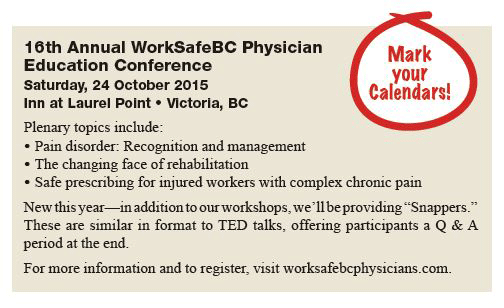A new partnership to benefit BC doctors and WorkSafeBC
As part of an agreement established in 2012, Doctors of BC and WorkSafeBC are working on a pilot project aimed at improving disability management for injured workers. They will do so through a collaborative Projects and Innovation Committee, which will explore, develop, and implement solutions considered mutually beneficial to both parties.
Since its inception, the committee has received and screened numerous project proposals from the physician community and from WorkSafeBC. To date, it has further developed and implemented—and is in the process of evaluating—the following two proposals. Should these proposals receive positive evaluations, they could then be applied province-wide.
Proposal 1: Epidemiology statement
Three MRI providers, along with the Section of Radiology, the Society of General Practitioners of BC, and WorkSafeBC, are working together to add an epidemiology statement as a footnote to all lumbar spine MRI reports. This will serve to educate requesting physicians and workers about the high prevalence of lumbar spine pathology seen on MRIs in patients without low back pain. The statement will read, “The following findings are so common in people without low back pain that although their presence may be reported, they must be interpreted with caution and in the context of the clinical situation.”[1] It will then go on to list the incidence of lumbar–spine related conditions in patients who don’t experience low back pain:
“Disk signal changes: 86%
Disk bulge: 65%
Loss of disk height: 57%
Annular tear: 42%
Endplate changes: 23%
Moderate or severe facet degeneration: 18%”[1]
Should the evaluation of this project prove fruitful, the committee may consider other imaging modalities and anatomic regions.
Proposal 2: Form for specialist’s consultation
In collaboration with WorkSafeBC, a number of orthopaedic surgeons in the Prince George area have developed a form that will be attached to the specialist’s consultation and copied to referring physicians and WorkSafeBC. The form will outline appropriate medical restrictions, limitations, and treatment recommendations. It is intended to provide early insight for the worker, WorkSafeBC, and the referring physician regarding the activities the worker can and cannot do while being treated or undergoing a further workup. WorkSafeBC will also use the form to help identify possible workplace accommodations in coordination with the worker (patient), employer, and physician.
All aspects of each project will undergo evaluation to assess their utility in addressing workplace disability.
If you would like more information on either of the projects currently under evaluation please contact one of the committee co-chairs: Tom Goetz, MD, at Doctors of BC (vansurgdoc@gmail.com), or Craig Martin, MD, at WorkSafeBC (craig.martin@worksafebc.com).
The Projects and Innovation Committee is actively seeking project ideas for 2015. If you have an idea for consideration, please contact one of the co-chairs listed above.
—Tom Goetz, MD, FRCSC
Orthopaedic Surgeon and WorkSafeBC Medical Advisor
—Craig Martin, MD
WorkSafeBC Manager of Clinical Services

hidden
This article is the opinion of WorkSafeBC and has not been peer reviewed by the BCMJ Editorial Board.
References
1. Jarvik JJ, Hollingworth W, Heagerty P, et al. The Longitudinal Assessment of Imaging and Disability of the Back (LAIDBack) Study: Baseline data. Spine 2001;26:1158-1166.

